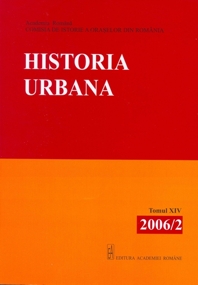Etapele evoluţiei urbane a Chişinăului
Stages of Urban Formation of Chişinău
Author(s): Tamara NesterovSubject(s): History
Published by: Editura Academiei Române
Keywords: urban genesis; urban development; Chişinău city; street trama; urban maps;
Summary/Abstract: Urban history of Chişinău knows not only two stages – till 1812 and after 1812–, but four with different judicial status and three urban, political factors determining the further way of development of locality. Identified in 1436 and till the end of the XVII century that it is a state initially of boyar afterward monastic village founded near Fântâna Mare (Great Fountain) (or – Albişoara). Intention of the regent Eustrate Dabija of outfit of Chişinău with detour for its rising at the rang of market fails due to its dependence on cloister Saint Friday (Sf. Vineri, or Balica) from Iaşi. Economic development of the locality situated on one of the most utilized way of communication from zone leads to the formation of Chişinău as market dependent on the closter. In 1739 the market Chişinău is destroyed by Turkish, afterward he extends on the narrow terrain situated downstream of river Bâc, on the estate of Buiucani village which was belonging to the cloister Sf. Arhangheli from Iaşi (later known as cloister Galata where was situated the gorge across the river utilized by the menzil (Turkish poste). It forms the commercial market which through its trapezoid outline confesses the genesis of the locality – market at crossing of ways. In short time Chişinău becomes the biggest market from the inter-river Prut-Nistru situated on the land of two cloisters. During a fight from December 1788, between Russian and Turkish army, the locality is set on fire together with those „6 or 7 churches”. The town is remaking at great pains, only on the eve of the year 1812 arriving at number of churches from previous period. After incorporation of the inter-river Prut-Nistru in the composition of Russian Empire, the territory occupied by Chişinău in 1818 is given by the cloisters to the „Russian crown” and the locality becomes the capital of region Basarabia. In its plane fixed in the first project of urban systematization from 1817, the street trama is dominated by directions of ways: of Turkish post became The Great Street of those of transit oriented to 2-3 gorges across river Bâc and of the river oriented to source The Great Fountain. Other streets represent the directions of relation with neighboring villages etc. After 1834, year where is confirmed the urban systematization plane, the town developed on two portions of the urban territory relatively independent. New Russian town is founded to the West of Chişinău on waste land where in 1789–1790 was previously cantoned the military Russian camping but without using grating remained from subdivisions. New town was created in orthogonal system, with rectangular districts whose size was dictated by the occupied district by Metropoly placed in the geometric circle of systematized Chişinău. The street trama of Ancient Town, medieval Chişinău, was pointed after what became, how it was characterized by contemporaries „chaotic, lack of logic, with devious streets” etc. Plane of Chişinău elaborated in first postwar years...
Journal: Historia Urbana
- Issue Year: XIV/2006
- Issue No: 2
- Page Range: 271-292
- Page Count: 22
- Language: Romanian
- Content File-PDF

